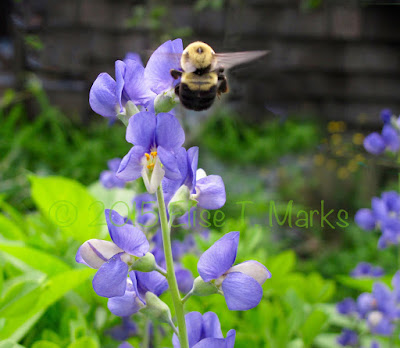False Indigo Being Visited By A Bee
(Baptisia australis)
Native to the prairies of southern North America
False indigo or baptisia, is a member of the Fabacea (aka Legumacea or legume) family with distinctive blue pea-like flowers. The flowers are bisexual and appear in upright racemes (spikes) in early June. The blue-black fruit ripens in late summer. It is about 2 inches long and filled with tiny, yellow-brown, kidney shaped seeds that rattle around inside once they have ripened. This gives the plant its common names Rattleweed and Rattlebush. Leaves are grey-green, trifoliate and arranged alternately upon the smooth stem which, if broken, releases sap that turns dark blue or purple upon contact with the air. The roots are woody, black and warty.
False indigo or baptisia, is a member of the Fabacea (aka Legumacea or legume) family with distinctive blue pea-like flowers. The flowers are bisexual and appear in upright racemes (spikes) in early June. The blue-black fruit ripens in late summer. It is about 2 inches long and filled with tiny, yellow-brown, kidney shaped seeds that rattle around inside once they have ripened. This gives the plant its common names Rattleweed and Rattlebush. Leaves are grey-green, trifoliate and arranged alternately upon the smooth stem which, if broken, releases sap that turns dark blue or purple upon contact with the air. The roots are woody, black and warty.
History and Folklore
The genus name Baptisia is derived from the greek ''bapto'', meaning "to immerse", in reference to the plant's usefulness in creating dyes for cloth. The specific name australis is Latin for "southern".
False indigo is native to North America and is most common in the Midwest. It was used by many Native peoples for various purposes including medicine and dye, which the Europeans later did as well. The name baptisia alludes to this practice. As the name false indigo implies, it can be used as a substitute for true indigo Indigofera tinctoria.
Harvesting & Storage
Flower and seed stalks can be hung upside down to dry and added to wreathes and floral arrangements.
Magical Attributes
Feminine in nature and associated with Venus, false indigo is an excellent protective herb. Plant it around your home for general protection, wear it on your person or use it in spells and amulets of a protective nature. It is especially useful for spells and amulets designed to protect pets and familiars, just make sure they don't get a hold of it and eat it because it is poison.
Household Use
The seed pods of wild blue indigo yield a lovely blue dye similar to that of true indigo. The dried seed pods are also quite pretty in floral arrangements.
This plant is said to repel flies from animals. To try this, hang a bunch of fresh flowers in your barn.
Healing Attributes
Baptisia is toxic and should not be used except under the care of an experienced practitioner. This herb should never be used by pregnant women.
This plant has been used as an antiseptic, a purgative and to combat coughs and fevers.
A tea of the roots has been used as an emetic and purgative, a poultice of the roots as an anti-inflammatory and small pieces were held in the mouth to treat toothaches.
A decoction of the stems has been used to stimulate the immune system and help the body fight of pneumonia, tuberculosis, influenza and other serious illnesses, especially of the upper respiratory system. It may also be used externally as a wash for smallpox and similar illnesses.
Side effects of ingesting blue indigo may include vomiting, diarrhea and gastrointestinal spasms.
False indigo is native to North America and is most common in the Midwest. It was used by many Native peoples for various purposes including medicine and dye, which the Europeans later did as well. The name baptisia alludes to this practice. As the name false indigo implies, it can be used as a substitute for true indigo Indigofera tinctoria.
Harvesting & Storage
Flower and seed stalks can be hung upside down to dry and added to wreathes and floral arrangements.
Magical Attributes
Feminine in nature and associated with Venus, false indigo is an excellent protective herb. Plant it around your home for general protection, wear it on your person or use it in spells and amulets of a protective nature. It is especially useful for spells and amulets designed to protect pets and familiars, just make sure they don't get a hold of it and eat it because it is poison.
Household Use
The seed pods of wild blue indigo yield a lovely blue dye similar to that of true indigo. The dried seed pods are also quite pretty in floral arrangements.
This plant is said to repel flies from animals. To try this, hang a bunch of fresh flowers in your barn.
Healing Attributes
Baptisia is toxic and should not be used except under the care of an experienced practitioner. This herb should never be used by pregnant women.
This plant has been used as an antiseptic, a purgative and to combat coughs and fevers.
A tea of the roots has been used as an emetic and purgative, a poultice of the roots as an anti-inflammatory and small pieces were held in the mouth to treat toothaches.
A decoction of the stems has been used to stimulate the immune system and help the body fight of pneumonia, tuberculosis, influenza and other serious illnesses, especially of the upper respiratory system. It may also be used externally as a wash for smallpox and similar illnesses.
Side effects of ingesting blue indigo may include vomiting, diarrhea and gastrointestinal spasms.
My photographs are available for purchase through EliseCreations.net
Thanks for your visits, favs and comments. As always, appreciated very much!
© all rights reserved by Elise T. Marks.
Please do not use this image on websites, blogs or any other media without my explicit written permission.


No comments:
Post a Comment